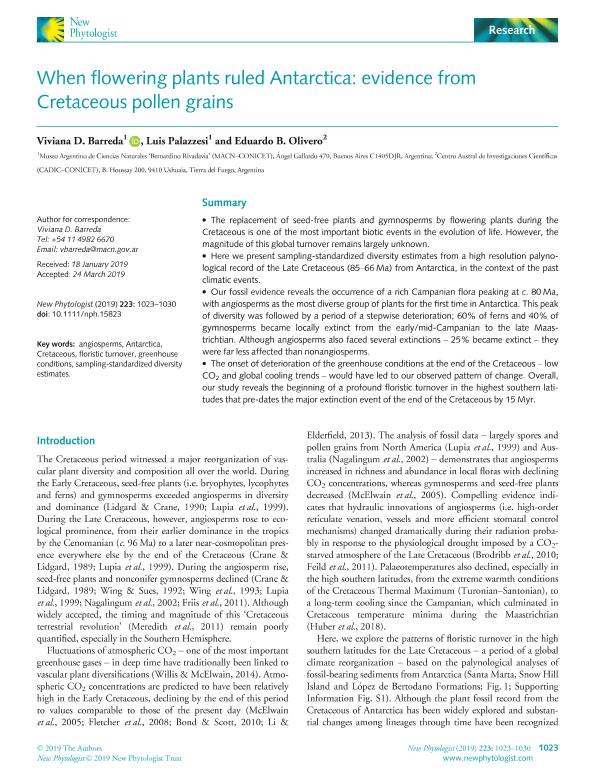Mostrar el registro sencillo del ítem
dc.contributor.author
Barreda, Viviana Dora

dc.contributor.author
Palazzesi, Luis

dc.contributor.author
Olivero, Eduardo Bernardo

dc.date.available
2020-12-21T14:12:33Z
dc.date.issued
2019-07
dc.identifier.citation
Barreda, Viviana Dora; Palazzesi, Luis; Olivero, Eduardo Bernardo; When flowering plants ruled Antarctica: evidence from Cretaceous pollen grains; Wiley Blackwell Publishing, Inc; New Phytologist; 223; 2; 7-2019; 1023-1030
dc.identifier.issn
0028-646X
dc.identifier.uri
http://hdl.handle.net/11336/120926
dc.description.abstract
The replacement of seed-free plants and gymnosperms by flowering plants during the Cretaceous is one of the most important biotic events in the evolution of life. However, the magnitude of this global turnover remains largely unknown. Here we present sampling-standardized diversity estimates from a high resolution palynological record of the Late Cretaceous (85–66 Ma) from Antarctica, in the context of the past climatic events. Our fossil evidence reveals the occurrence of a rich Campanian flora peaking at c. 80 Ma, with angiosperms as the most diverse group of plants for the first time in Antarctica. This peak of diversity was followed by a period of a stepwise deterioration; 60% of ferns and 40% of gymnosperms became locally extinct from the early/mid-Campanian to the late Maastrichtian. Although angiosperms also faced several extinctions – 25% became extinct – they were far less affected than nonangiosperms. The onset of deterioration of the greenhouse conditions at the end of the Cretaceous – low CO2 and global cooling trends – would have led to our observed pattern of change. Overall, our study reveals the beginning of a profound floristic turnover in the highest southern latitudes that pre-dates the major extinction event of the end of the Cretaceous by 15 Myr.
dc.format
application/pdf
dc.language.iso
eng
dc.publisher
Wiley Blackwell Publishing, Inc

dc.rights
info:eu-repo/semantics/openAccess
dc.rights.uri
https://creativecommons.org/licenses/by-nc-sa/2.5/ar/
dc.subject
ANGIOSPERMS
dc.subject
ANTARCTICA
dc.subject
CRETACEOUS
dc.subject
FLORISTIC TURNOVER
dc.subject
GREENHOUSE CONDITIONS
dc.subject
SAMPLING-STANDARDIZED DIVERSITY ESTIMATES
dc.subject.classification
Paleontología

dc.subject.classification
Ciencias de la Tierra y relacionadas con el Medio Ambiente

dc.subject.classification
CIENCIAS NATURALES Y EXACTAS

dc.title
When flowering plants ruled Antarctica: evidence from Cretaceous pollen grains
dc.type
info:eu-repo/semantics/article
dc.type
info:ar-repo/semantics/artículo
dc.type
info:eu-repo/semantics/publishedVersion
dc.date.updated
2020-11-26T17:54:03Z
dc.journal.volume
223
dc.journal.number
2
dc.journal.pagination
1023-1030
dc.journal.pais
Reino Unido

dc.journal.ciudad
Londres
dc.description.fil
Fil: Barreda, Viviana Dora. Consejo Nacional de Investigaciones Científicas y Técnicas. Oficina de Coordinación Administrativa Parque Centenario. Museo Argentino de Ciencias Naturales "Bernardino Rivadavia"; Argentina
dc.description.fil
Fil: Palazzesi, Luis. Consejo Nacional de Investigaciones Científicas y Técnicas. Oficina de Coordinación Administrativa Parque Centenario. Museo Argentino de Ciencias Naturales "Bernardino Rivadavia"; Argentina
dc.description.fil
Fil: Olivero, Eduardo Bernardo. Consejo Nacional de Investigaciones Científicas y Técnicas. Centro Austral de Investigaciones Científicas; Argentina
dc.journal.title
New Phytologist

dc.relation.alternativeid
info:eu-repo/semantics/altIdentifier/doi/http://dx.doi.org/10.1111/nph.15823
dc.relation.alternativeid
info:eu-repo/semantics/altIdentifier/url/https://nph.onlinelibrary.wiley.com/doi/full/10.1111/nph.15823
Archivos asociados
